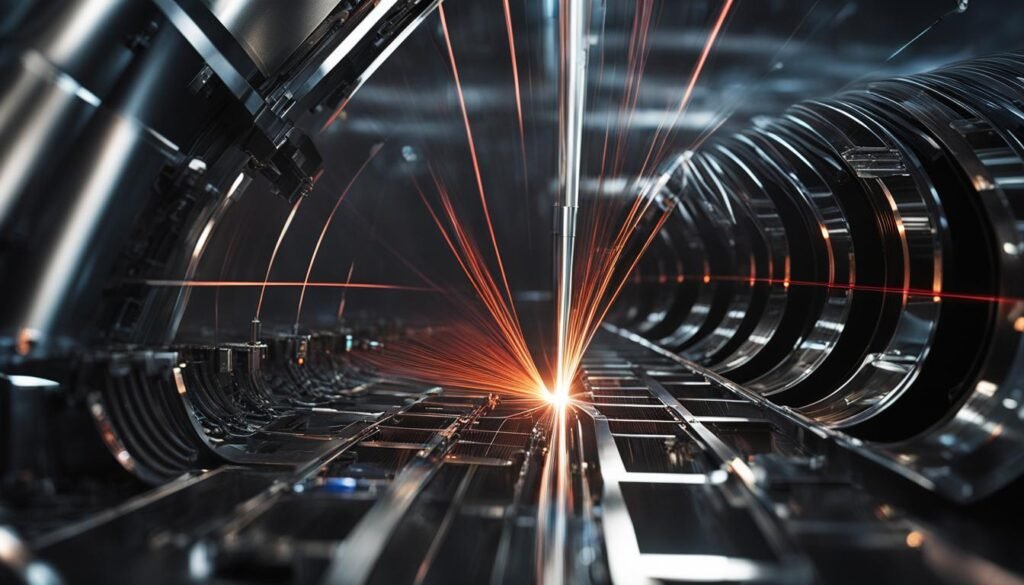Optomechanics with lasers is an intriguing field that explores the interaction between optical fields and mechanical motion. By harnessing the power of lasers, this innovative approach enhances the transfer of energy between light and matter, offering exciting possibilities for various applications and future advancements.
Contents
- 1 The Optomechanical Laser Cavity
- 2 Optomechanical Effects: Forces and Potential
- 3 Quantized Energy Transfer and Cooling
- 4 Regimes of Operation: Red-Detuned, Heating, and Resonance
- 5 Applications of Optomechanics with Lasers
- 6 Future Paths and Developments
- 7 Conclusion
- 8 FAQ
- 8.1 What is cavity optomechanics?
- 8.2 What is the optomechanical laser cavity?
- 8.3 What are the effects of optomechanical interactions?
- 8.4 How does quantized energy transfer and cooling work?
- 8.5 What are the different regimes of operation in optomechanics?
- 8.6 What are the applications of optomechanics with lasers?
- 8.7 What does the future hold for optomechanics with lasers?
- 9 Source Links
Key Takeaways:
- Optomechanics with lasers focuses on the interaction between optical fields and mechanical motion.
- Lasers drive mechanical oscillators, enabling the transfer of energy between light and matter.
- Applications of optomechanics with lasers include quantum entanglement, ultrasensitive measurement, and all-optical RF signal processing.
- The integration of mechanical oscillators as mirrors in laser cavities opens up opportunities for high-speed wavelength-swept light sources and improved 3D imaging.
- The future of optomechanics with lasers holds immense potential for advancements in quantum sensing, gravitational wave detection, and integrated on-chip sensors.
The Optomechanical Laser Cavity
The optomechanical laser cavity is a crucial component in laser optomechanics. It features an ultra-lightweight high-contrast-grating (HCG) mirror and a mechanical oscillator. The HCG mirror, made of InP grating, reflects over 99.5% of surface-normal light and acts as the top mirror of a vertically-cavity surface-emitting laser (VCSEL). This mirror is designed to have a strong dependency on the lasing wavelength, enabling wavelength tuning by electrostatically displacing the mirror.
The mechanical oscillator, coupled to the HCG mirror, exhibits a high mechanical quality factor and can induce regenerative oscillation of the laser optomechanical cavity. The optomechanical laser cavity offers enhanced light-matter interaction and provides opportunities for various applications.
To visually illustrate the structure of the optomechanical laser cavity, refer to the image below:
Table: Comparison of Optomechanical Laser Cavity Components
| Component | Description |
|---|---|
| Ultra-light Weight High-Contrast-Grating Mirror | An InP grating mirror that reflects more than 99.5% of surface-normal light and serves as the top mirror of a VCSEL. |
| Mechanical Oscillator | A device coupled to the high-contrast-grating mirror that exhibits high mechanical quality factor and induces regenerative oscillation. |
In summary, the optomechanical laser cavity comprises the ultra-lightweight high-contrast-grating mirror and the mechanical oscillator. This combination enables enhanced light-matter interaction and presents exciting opportunities for applications in optomechanics with lasers.
Optomechanical Effects: Forces and Potential
In the fascinating field of optomechanics with lasers, the interaction between light and mechanics leads to a variety of intriguing effects. One of the key effects is known as radiation pressure. When light interacts with a mechanical oscillator, each photon carries a momentum that can be transferred to the oscillator, resulting in a radiation pressure force. This force causes the oscillator to vibrate.
The radiation pressure force can also be seen as a potential, known as the optical spring effect. This effect modifies the mechanical spring constant, influencing the behavior of the oscillator. The cavity length modulation, caused by the oscillator’s motion, affects the resonance frequency of the cavity and the amplitude of the light inside the cavity. As a result, the radiation pressure and the light-matter interaction are enhanced.
The optomechanical effects of radiation pressure and the optical spring effect play a crucial role in the field of optomechanics with lasers. These effects open up new possibilities for applications such as quantum entanglement, ultrasensitive measurement, and all-optical RF signal processing. By harnessing and controlling these effects, researchers are uncovering exciting opportunities for advancements in various fields of research and technology.
Summary:
- Optomechanics with lasers involves the interaction between light and mechanics.
- Radiation pressure is an effect where each photon carries momentum that can transfer to a mechanical oscillator, causing it to vibrate.
- The optical spring effect is a potential that modifies the mechanical spring constant and enhances the light-matter interaction.
- These optomechanical effects have applications in quantum entanglement, ultrasensitive measurement, and all-optical RF signal processing.
Quantized Energy Transfer and Cooling
The optomechanical cavity in laser optomechanics enables the transfer of energy between photons and phonons at the quantum level. By detuning the laser frequency from the cavity resonance frequency, a mechanism called quantized energy transfer occurs. In this process, photons can enter the cavity by taking away energy from the mechanical oscillator in the form of phonons. This energy transfer causes the mechanical oscillator to cool down, ultimately reaching a balance with heating mechanisms from the environment and laser noise. The cooling effect induced by quantized energy transfer is crucial for achieving the quantum regime, where the impact of thermal noise becomes negligible.
The cooling phenomenon in the optomechanical cavity relies on the principles of radiation pressure and the optical spring effect. Radiation pressure arises from the momentum carried by photons, which can be transferred to the mechanical oscillator, leading to its vibration. The optical spring effect, on the other hand, arises from the modification of the mechanical spring constant due to the radiation pressure potential. These effects, together with the cavity length modulation caused by the oscillator’s motion, result in enhanced light-matter interaction and radiation pressure within the optomechanical cavity.
To fully understand the mechanics of cooling in the optomechanical cavity, it is essential to consider the interplay between phonons and photons. The detuning between the laser frequency and the cavity resonance frequency determines the behavior of the system. In the red-detuned regime, the cooling effect dominates as phonons and photons undergo state exchange, resulting in the cooling of the mechanical oscillator. Conversely, in the heating regime, where the detuning is on the blue side, the mechanical motion amplifies. The resonance regime occurs when the detuning approaches zero, and the cavity and laser frequencies align. Each regime exhibits different effects on the optomechanical system and can be leveraged for specific applications.
| Regime | Detuning | Effect |
|---|---|---|
| Red-Detuned | Detuned towards the red side | Cooling of the mechanical oscillator |
| Heating | Detuned towards the blue side | Amplification of the mechanical motion |
| Resonance | Detuning close to zero | Enhanced light-matter interaction |
The optomechanical cavity in laser optomechanics facilitates the transfer of energy between photons and phonons at the quantum level. Through quantized energy transfer, cooling of the mechanical oscillator can be achieved. The cooling process relies on the principles of radiation pressure and the optical spring effect. By detuning the laser frequency from the cavity resonance frequency, the system exhibits different regimes: red-detuned, heating, and resonance. These regimes determine the direction and magnitude of the cooling or amplification effect on the mechanical motion.
Regimes of Operation: Red-Detuned, Heating, and Resonance
Understanding the different regimes of operation is essential in the field of optomechanics with lasers. These regimes are based on the detuning between the laser frequency and the cavity resonance frequency, and they have distinct effects on the behavior of the system.
Regime 1: Red-Detuned
In the red-detuned regime, the laser frequency is lower than the cavity resonance frequency. This regime is characterized by the exchange of energy between the mechanical oscillator and the optical field, allowing for cooling of the oscillator. The energy transfer occurs as photons carry away energy from the oscillator in the form of phonons. This cooling process can lead to the preparation of the mechanical oscillator in its quantum ground state, enabling ultrasensitive measurements and quantum sensing applications.
Regime 2: Heating
In the heating regime, the laser frequency is higher than the cavity resonance frequency. This detuning leads to an amplification of the mechanical motion. The optical field transfers energy to the mechanical oscillator, resulting in an increase in its amplitude. This regime is useful for studying non-linear dynamics and understanding the behavior of optomechanical systems under different driving conditions.
Regime 3: Resonance
The resonance regime occurs when the laser frequency is precisely matched to the cavity resonance frequency. In this regime, the interaction between the optical field and the mechanical oscillator is maximized. The cavity length modulation due to the mechanical motion enhances the light-matter interaction, leading to enhanced radiation pressure and optical spring effects. The resonance regime is crucial for achieving strong optomechanical coupling and is often utilized in applications that require precise control of the mechanical motion.
By exploring these different regimes, researchers can gain deeper insights into the optomechanical interactions and harness their unique characteristics for a wide range of applications. Whether it’s achieving ultra-sensitive measurements, studying non-linear dynamics, or enabling precise control of mechanical motion, the understanding of the red-detuned, heating, and resonance regimes paves the way for advancements in optomechanics with lasers.
Applications of Optomechanics with Lasers

Optomechanics with lasers has emerged as a groundbreaking field with a wide range of applications. The enhanced light-matter interaction provided by optomechanics offers unique opportunities for various fields of research and technology. Let’s explore some of the exciting applications that optomechanics with lasers has to offer.
Quantum Sensing
One of the key applications of optomechanics with lasers is in quantum sensing. By utilizing the interaction between light and mechanical motion, optomechanics enables ultrasensitive measurement of displacements and forces. This makes it possible to detect and analyze quantum states with unprecedented precision. Optomechanics-based quantum sensors have the potential to revolutionize fields such as precision metrology, gravitational wave detection, and quantum information processing.
Gravitational Wave Detection
Gravitational waves, ripples in the fabric of spacetime, provide valuable insights into the mysteries of the universe. Optomechanics with lasers plays a crucial role in interferometric detectors used for gravitational wave detection. By carefully considering optomechanical effects in the design and operation of these detectors, scientists can achieve higher sensitivity and accuracy in detecting gravitational waves. The integration of optomechanical components allows for precise measurements of minute displacements caused by passing gravitational waves, opening up new possibilities for studying the cosmos.
Optomechanical Sensors
The integration of optomechanical systems on a chip has led to the development of optomechanical sensors that offer unique advantages. These on-chip sensors can be used for a wide range of applications, including precision measurements, environmental monitoring, and biomedical sensing. The enhanced light-matter interaction provided by optomechanics enables highly sensitive detection and analysis of physical and biochemical quantities. Optomechanical sensors hold great promise for future advancements in miniaturized and highly efficient sensing technologies.
| Applications | Description |
|---|---|
| Quantum Sensing | Ultrasensitive measurement of displacements and forces, revolutionizing precision metrology, gravitational wave detection, and quantum information processing. |
| Gravitational Wave Detection | Integration in interferometric detectors for higher sensitivity and accuracy in detecting gravitational waves, providing insights into the mysteries of the universe. |
| Optomechanical Sensors | On-chip sensors offering highly sensitive detection and analysis of physical and biochemical quantities, promising advancements in miniaturized sensing technologies. |
Optomechanics with lasers is paving the way for groundbreaking advancements in various fields of research and technology. From quantum sensing to gravitational wave detection and optomechanical sensors, the applications of optomechanics with lasers are vast and intriguing. As research continues and new developments arise, we can expect to see even more innovative applications and exciting possibilities in the future.
Future Paths and Developments

The field of optomechanics with lasers is constantly evolving, with ongoing research and technological advancements driving new possibilities and developments. Scientists and engineers are focused on further understanding and controlling optomechanical interactions, exploring new regimes and phenomena, and pushing the boundaries of what is possible in this exciting field.
One area of future development is in nanofabrication techniques and materials. Advances in these areas may lead to the development of even more efficient and versatile optomechanical devices. By leveraging the unique properties of novel materials and refining fabrication processes, researchers aim to enhance the performance and functionality of optomechanical systems.
Another future path for optomechanics with lasers lies in its applications. The enhanced light-matter interaction offered by this field opens up new opportunities in various areas of research and technology. For example, in the field of 3D imaging, optomechanics with lasers can lead to improved light sources, enabling higher resolution and better quality imaging. In quantum information processing, optomechanics with lasers can play a key role in the development of devices and systems for quantum computing and communication.
| Future Paths | Developments |
|---|---|
| Advanced Nanofabrication Techniques | Refining fabrication processes and exploring novel materials to enhance the efficiency and versatility of optomechanical devices. |
| Applications in 3D Imaging | Improving light sources for higher resolution and better quality imaging. |
| Quantum Information Processing | Contributing to the development of devices and systems for quantum computing and communication. |
| Integration with Other Technologies | Collaborating with other fields such as nanophotonics, quantum optics, and microfabrication to create hybrid systems with enhanced capabilities. |
Additionally, the future of optomechanics with lasers involves exploring the integration of this field with other technologies. Collaborations with fields like nanophotonics, quantum optics, and microfabrication can lead to the development of hybrid systems that combine the strengths of each discipline. These hybrid systems can offer enhanced capabilities and open up new avenues for research and applications.
Overall, the future of optomechanics with lasers holds great promise. With ongoing advancements in technology and a growing understanding of the underlying principles, this field is set to continue making significant contributions to science and technology. From advanced nanofabrication techniques to exciting applications and interdisciplinary collaborations, the developments and future paths in optomechanics with lasers are sure to shape the landscape of research and technology in the years to come.
Conclusion
Optomechanics with lasers is a fascinating field that explores the interaction between optical fields and mechanical motion. By integrating mechanical oscillators within laser cavities, this technology enhances the transfer of energy between light and matter. The possibilities offered by optomechanics with lasers are immense, with applications ranging from quantum sensing to gravitational wave detection and on-chip sensors.
With ongoing research and technological advancements, the future of optomechanics with lasers is promising. Scientists are striving to further understand and control optomechanical interactions, uncovering new phenomena and exploring new regimes. Nanofabrication techniques and materials advancements hold the potential for even more efficient and versatile optomechanical devices.
Optomechanics with lasers is poised to revolutionize various fields, including 3D imaging, quantum information processing, and on-chip RF clock generation. The integration of optical fields and mechanical motion opens up new avenues for discovery and technological breakthroughs. As we continue to push the boundaries of this field, the role of optomechanics with lasers in shaping the future of optics and mechanical systems will only become more significant.
FAQ
What is cavity optomechanics?
Cavity optomechanics explores the interaction between optical fields and mechanical motion, using lasers to enhance the transfer of energy between light and matter.
What is the optomechanical laser cavity?
The optomechanical laser cavity is a key component in laser optomechanics and consists of an ultra-lightweight high-contrast-grating mirror and a mechanical oscillator.
What are the effects of optomechanical interactions?
The interaction between light and mechanics leads to effects such as radiation pressure and the optical spring effect, which modify the mechanical motion and enhance the light-matter interaction.
How does quantized energy transfer and cooling work?
By detuning the laser frequency from the cavity resonance frequency, photons can enter the cavity and cool down the mechanical oscillator, reaching the quantum regime where thermal noise effects are negligible.
What are the different regimes of operation in optomechanics?
The different regimes include the red-detuned regime for cooling, the heating regime for amplification of mechanical motion, and the resonance regime for specific applications.
What are the applications of optomechanics with lasers?
Optomechanics with lasers has applications in quantum sensing, gravitational wave detection, on-chip sensors, and more, offering enhanced light-matter interaction and ultrasensitive measurement capabilities.
What does the future hold for optomechanics with lasers?
Ongoing research aims to further understand and control optomechanical interactions, exploring new regimes and phenomena, with the potential for breakthroughs in 3D imaging, quantum information processing, and more.



